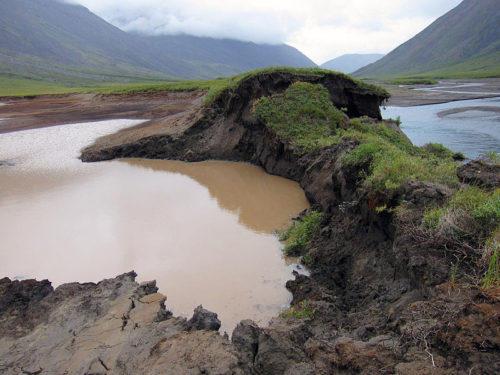One of the many serious consequences of the climate crisis is that precious permafrost is thawing, and this is unleashing even more carbon to the atmosphere and further exacerbating climate change. However, it’s complicated. For example, sometimes permafrost can thaw rapidly and scientists are unsure why and what these abrupt thaws mean in terms of feedback loops. This makes it difficult to predict the future impact on the climate. Thanks to an ESA–NASA initiative, new research digs deep into understanding the complexities of permafrost thaw and how carbon is released over time.
Permafrost is frozen soil, rock or sediment – sometimes hundreds of metres thick. To be classified as permafrost, the ground has to have been frozen for at least two years, but much of the subsurface in the polar regions has remained frozen since the ice age. Permafrost holds carbon-based remains of vegetation and animals that froze before decomposition could set in.
Most of Earth’s permafrost is in the northern hemisphere – Arctic permafrost stores almost 1700 billion tonnes of carbon.
The animation below shows how the extent of permafrost in the Arctic changed between 1997 and 2019.
Permafrost plays a critical role in keeping our planet from losing its cool, but the rise in global temperatures, particularly evident in the Arctic, is causing the subsurface ground to thaw and release long-held carbon to the atmosphere.
The image below shows how the how the subsurface is warming, risking permafrost thaw.
Highlighting the importance of permafrost in the climate system, the journal Nature Reviews Earth & Environment recently featured a wealth of research papers in a special collection that examines the physical, biogeochemical and ecosystem changes related to permafrost thaw and the associated impacts.
One of the papers in the collection is based on research conducted through the ESA–NASA Arctic Methane and Permafrost Challenge.

The paper describes how scientists from Europe and the US are working together to better track permafrost carbon dynamics. This includes gaining a better understanding of the mechanisms that lead to abrupt thaws through the use of key observations of carbon release and developing models to predict permafrost–carbon feedback.
The image below show the amount of carbon stored in the upper 2 m of permafrost.
Abrupt thawing and thermokarst, which is a fast process of permafrost degradation but varies significantly depending on local conditions, can emit substantial amounts of carbon to the atmosphere very quickly, even in a matter of days. These processes risk mobilising the deep, legacy carbon sequestered in yedoma. Yedoma is a type of permafrost that formed between 1.8 million and 10 000 years ago, and is particularly rich in organic material, so a significant source of atmospheric methane.
Increasingly frequent wildfires in the Arctic will also lead to a notable and unpredictable carbon flux.
The paper’s lead author, Kimberley Miner, from NASA Jet Propulsion Laboratory, said, “The traditional view of permafrost thaw is that it is a gradual process that exposes layers slowly. Abrupt thawing exposes old permafrost layers far more quickly.
“Scaling is a real challenge but our research focuses on understanding emissions of carbon across different timescales – from the microbially mediated release at soil level, to wildfire dynamics across the tundra.
“Similarly, we need to use observational methods across scales, from in-situ fieldwork to satellite observations to mirror thaw timescales. Only with data covering days to years to decades can we substantially reduce uncertainties in our understanding of what may trigger rapid thaws, predict emission rates and then have a better picture of the feedback cycles involved.”
The paper not only highlights the dangers of rapid permafrost thaw but also calls for more detailed monitoring through in-situ, airborne and satellite observations to provide a deeper understanding of the Arctic’s future role as a carbon source or sink, and the subsequent impact on the Earth system.
Charles Miller, also from JPL, said, “Our understanding of permafrost is of course advancing all the time. Permafrost cannot be directly observed from space, we have to combine different measurements such as land-surface temperature and soil moisture to give us a picture of change. And, thanks to satellites, we have a record going back over 20 years that details changes to the northern hemisphere’s permafrost soils – and this is key to improving climate models.
“However, we look forward to future in-situ measurements and future satellite systems to give us more information.”
ESA’s Diego Fernandez added, “Thanks to missions such as ESA’s SMOS and Copernicus Sentinel-5P, the research being conducted as part of the ESA–NASA Arctic Methane and Permafrost Challenge within ESA’s FutureEO programme and ESA’s Climate Change Initiative is once again proving essential to better understand the effects climate change is having on the delicate Arctic environment, and how these changes, in turn, add to the climate crisis.
“As part of the Arctic Methane and Permafrost Challenge, ESA and NASA aim to support strong scientific collaboration from both sides of the Atlantic to tackle jointly the scientific and societal issues associated with permafrost thaw.”
In the future, upcoming missions such as the German–French MERLIN, planned to launch in 2027, uses laser technology and shows promise to add valuable methane data to the Arctic observing system.
Also, the Copernicus Carbon Monitoring mission, which is scheduled for launch in 2025, will provide high-frequency data to better monitor carbon emissions from thawing permafrost.
Groundwork is also essential for understanding how greenhouse gases are being emitted from the Arctic. For example, last year, ESA was involved in an international research campaign based in Sweden. The Monitoring of Atmospheric Composition and Greenhouse Gases through Multi-Instrument campaign included launching balloons into the stratosphere, flying instrumentation on aircraft and taking measurements on the ground to record climate gas sources and sinks in Scandinavia.
Similar activities will be continued in the North American Arctic in the summer of 2022 as part of Arctic Boreal Vulnerability Experiment and the Carbon Dioxide and Methane mission. Both of these airborne campaigns are led by NASA and German Aerospace Center, respectively.









